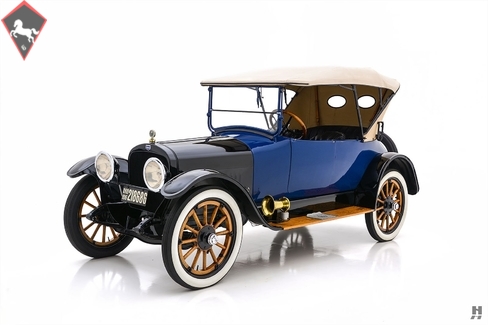Auburn Six 6-38 Roadster 1916
General description :
Much of Auburn’s history is dominated by the brief but glamorous period that followed in the wake of E.L. Cord’s takeover. The era that brought us the Auburn Twelve and the Supercharged 852 Speedster was undoubtedly a high point for the company, but it would be an injustice to the storied marque to allow the brief Cord era to overshadow all the cars that preceded it. Near the turn of the twentieth century, a former wheelwright named Charles Eckhart left his position at the Studebaker Corporation to branch out on his own in the carriage business. In 1874 he founded the eponymous Eckhart Carriage Company. In 1894, Charles retired and left the business to his two sons, who in turn built the company’s first experimental automobile in 1900. The name of the company changed to the Auburn Automobile Company after the firm’s home base in Indiana, and production began in earnest in 1903, with a single-cylinder, chain drive runabout.
The product line grew steadily in terms of size, cylinder count, and output, leading to the arrival of their first six-cylinder model by 1912. Like other manufacturers, Auburn turned to outside suppliers for its engine range, using as many as three different companies at once. In 1916, Auburn found themselves in a transitional period as the Eckharts were in poor health and shopping for a new owner. Despite the struggles, the company soldiered on with a range that included three distinct models. Leading the way as the value-model was 4-38 with a T-head four-cylinder Teetor engine. That car was followed by the Model 6-38 “Light Six.” As its name suggests, this car had a 38 horsepower, 212 cubic-inch six-cylinder engine. According to the book “Auburn & Cord” (Beck and Malks, 1996), the light six engines came from Model Gas Engine Works in Auburn. At the top of the range sat the Model 6-40, which found the most buyers out of the three models, despite being the most expensive. Customers had the choice of either a 5-passenger touring or a distinct and sporting 4-passenger roadster body for each of the chassis options. Such was the Model 6-40’s dominance that today, light six and four-cylinder models exceedingly rare. These formative motorcars established Auburn’s reputation for quality and value, which held on despite the subsequent management woes that led to Auburn’s eventual demise after 1936.
Equipped with the sporting close-coupled roadster coachwork, this Auburn 6-38 Light Six is an excellent example of this rarely seen model. The distinctly sporty Chummy Roadster body features a sloping rear deck, rear-mounted spare, and individual front bucket seats. It is an unusual sight since most Auburn buyers opted for the traditional touring model. The earliest history of this car is not known, although the period Ohio registration points to a likely home state. It is believed the car appeared for sale at the 1986 Auburn, Indiana fall show. Documents in the history file show that the next owner purchased the roadster at the Auburn Fall auction in 1991. This Auburn remained a cherished part of his collection from 1991 through early 2019.
Today, this rare and sporting Auburn presents in good condition, with a well-preserved older restoration displaying abundant character and an attractive, moderate patina. The two-tone black and blue paint suits the body lines well, accented with wooden artillery wheels, whitewall tires, and a tan canvas top. The paintwork is glossy and in sound order, and while close inspection reveals some imperfections, it remains quite attractive and well-suited to an enjoyable tour car such as this. Accessories include a brass electric horn on the running board, suitcase holder on the passenger side, and a nickel Moto-Meter topping the painted radiator shell.
The most interesting feature of the close-coupled four-passenger cockpit is the pair of front bucket seats which are a surprisingly sporty touch for the period. Black upholstery on the front seats, rear bench, and interior paneling have a consistent character, feeling well broken-in yet in excellent overall condition for the age. A tan canvas top and a full complement of side curtains accompany the car, making it well suited to long-distance touring.
The six-cylinder engine presents in good, tidy condition, with period-correct gray paint and a single updraft Rayfield carburetor. It mates to a three-speed sliding gear transmission, with shaft drive to the rear axle. Following a period of disuse in the previous owner’s collection, the Auburn would benefit from some mechanical sorting before embarking on any long journeys.
With its attractive and sporting coachwork, this fascinating early Auburn is sure to appeal virtually any aficionado of the marque and is ideally equipped for touring and road events. Few examples from this early era survive, yet they are formative elements in the history of the great Auburn Automobile Company.
https://hymanltd.com/vehicles/6468
1916 Auburn Six 6-38 Roadster is listed sold on ClassicDigest in St. Louis by Mark Hyman for $39500.
Car Facts
Car type : Car Make : Auburn Model : Six Model Version : 6-38 Roadster Engine size : 0.0 Model Year : 1916 Sub type : Convertible Location : Missouri
Sold
Seller Information
Sold
Other cars listed for sale by this dealer
About Auburn
The Auburn Automobile Company was initially known as Eckhart Carriage Company, founded in Auburn, Indiana in 1874 , where they experimented making automobiles before actually entering the business.In 1926, Cord -then the owner of Auburn- after numerious and intricate ownership changes, partnered with Duesenberg Corporation. This was a collaboration to produce the fines automobiles in the American history.
Employing imaginative minds such as chief designer Alan Leamy, Cord built cars such as the Duesenberg Model J (1928-37), the Auburn Speedster (1935-37), the 851 Speedster, and the Cord 810/812 that became famous for their advanced engineering as well as their striking appearance. It was the first American-designed and built front wheel drive car with independent front suspension and hiding headlights.
The Depression, coupled with Cord's stock manipulations, finally killed the company in 1937.






